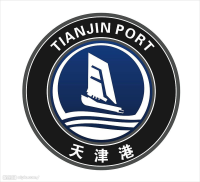
Back ميناء تيانجين Arabic থিয়েনচিন বন্দর Bengali/Bangla Hafen Tianjin German Tianjingo portua Basque Tianjinin satama Finnish Port de Tianjin French Porto di Tientsin Italian Тяньцзинь порты Kazakh Tiandzino uostas Lithuanian Haven van Tianjin Dutch
This article may require copy editing for grammar, style, cohesion, tone, or spelling. (April 2024) |
| Port of Tianjin 天津港 | |
|---|---|
 Logo of the Port of Tianjin | |
 Click on the map for a fullscreen view | |
| Location | |
| Country | People's Republic of China |
| Location | Tianjin |
| Coordinates | 38°58′33″N 117°47′15″E / 38.97583°N 117.78750°E |
| UN/LOCODE | CNTXG or CNTSN (formerly CNTJP/CNTGU)[1] |
| Details | |
| Opened | 1860 (Port of Tanggu); 1952-10-17 (Tianjin Xingang reopening) |
| Operated by | Tianjin Port Group Ltd |
| Owned by | Tianjin State-owned Assets Supervision and Administration Commission |
| Type of harbour | Deep-water Seaport/Riverport |
| Land area | 121 km2[2] |
| Size | 260 km2 (470 km2 total jurisdictional area) |
| No. of berths | 217; Production Berths: 140 (2010)[3] |
| Employees | 20,000 (2008) |
| Chairman | Yu Rumin |
| World Port Index Number | 60190 |
| Nautical Charts | 94363/0 (NGA/NIMA); 2653/4 (Admiralty); 11773/4(Chinese) |
| Statistics | |
| Annual cargo tonnage | 500 million tonnes (2013) |
| Annual container volume | 13 million TEU (2013) |
| Value of cargo | 197.249 billion USD (2011)[4] |
| Passenger traffic | 110,000 cruiser passengers (2012)[5] |
| Annual revenue | 21.5 billion RMB (2011)[6] |
| Net income | 1.678 billion RMB (2011)[7] |
| Website http://www.ptacn.com | |
The Port of Tianjin (Tianjin Gang, Chinese: 天津港; pinyin: tiānjīn gǎng), formerly known as the Port of Tanggu, is the largest port in Northern China and the main maritime gateway to Beijing. The name "Tianjin Xingang" (Chinese: 天津新港; pinyin: tiānjīn xīngǎng; lit. 'Tianjin New Port'), which strictly speaking refers only to the main seaport area, is sometimes used to refer to the whole port. The port is on the western shore of the Bohai Bay, centred on the estuary of the Haihe River, 170 km southeast of Beijing and 60 km east of Tianjin city. It is the largest man-made port in mainland China,[8] and one of the largest in the world. It covers 121 square kilometers of land surface, with over 31.9 km of quay shoreline and 151 production berths at the end of 2010.[9]
Tianjin Port handled 500 million tonnes of cargo and 13 million TEU of containers in 2013,[10] making it the world's fourth largest port by throughput tonnage and the ninth in container throughput.[11] The port trades with more than 600 ports in 180 countries and territories around the world.[3] It is served by over 115 regular container lines.[12] run by 60 liner companies, including all the top 20 liners. Expansion in the last two decades has been enormous, going from 30 million tonnes of cargo and 490,000 TEU[13] in 1993 to well beyond 400 million tonnes and 10 million TEU in 2012.[14] Capacity is still increasing at a high rate, with 550–600 Mt of throughput capacity expected by 2015. The large volume of port traffic and high urban population makes Tianjin a Large-Port Megacity, the largest type of port-city in the world.[15]
The port is part of the Binhai New Area district of Tianjin Municipality, the main special economic zone of northern China, and it lies directly east of the TEDA. The Port of Tianjin is at the core of the ambitious development program of the BNA and, as part of that plan, the port aims to become the primary logistics and shipping hub of North China.
On 12 August 2015, at least two explosions within 30 seconds of each other occurred at a container storage station at the Port of Tianjin in the Binhai New Area of Tianjin, China. The cause of the explosions was not immediately known, but initial reports pointed to an industrial accident. Chinese state media said that at least the initial blast was from unknown hazardous materials in shipping containers at a plant warehouse owned by Ruihai Logistics, a firm specializing in handling hazardous materials.
- ^ "UNLOCODE (CN) - CHINA". unece.org. Archived from the original on 13 May 2021. Retrieved 9 February 2021.
- ^ "天津港:从"淤泥港"到"全球第四大港"". Chinaports Network (中国海口网). 2010-07-09. Archived from the original on 2015-06-21. Retrieved 2012-09-24.
- ^ a b "天津港简介". Port Services Office of the Tianjin People's Government. Archived from the original on 2012-04-26. Retrieved 2011-12-10.
- ^ "天津口岸2011年发展情况". 天津市人民政府口岸服务办公室(Port Service Office of Tianjin People's Government). 2012-04-24. Archived from the original on 2014-10-21. Retrieved 2012-09-27.
- ^ "2012天津港接待豪华邮轮35艘次". Tianjin Port Group. 2012-11-13. Archived from the original on 2013-01-20. Retrieved 2013-01-07.
- ^ "2011天津港十大新闻". 天津港湾 (Tianjin Harbor News). 2012-02-23. Archived from the original on 2014-02-02. Retrieved 2012-03-06.
- ^ "天津港(集团)有限公司201 2 年度第一期 短期融资券募集说明书" (PDF). Tianjin Port Group. June 2012. Archived (PDF) from the original on 2016-01-20. Retrieved 2012-10-21.
- ^ "天津港欢迎您!". Ptacn.com. Archived from the original on 2008-05-30. Retrieved 2011-12-10.
- ^ "天津港简介". 天津市人民政府口岸服务办公室 (Port Service Office of Tianjin People's Government). www.tjport.gov.cn/kaxx9.htm. Archived from the original on 2012-04-26. Retrieved 2011-12-10.
- ^ "天津港货物吞吐量突破五亿吨". Tianjin Port Group. 2013-12-30. Archived from the original on 2015-08-17. Retrieved 2014-02-18.
- ^ "Shanghai Retains Its Top Position in World's Box Port Ranking". Japan International Freight Forwarders Association Inc. 2014-01-31. Archived from the original on 2014-02-22. Retrieved 2014-02-18.
- ^ "天津港全年集装箱吞吐量突破1000万标准箱". News.xd56b.com. Archived from the original on 2011-08-23. Retrieved 2011-12-10.
- ^ "创建亿吨大港 实现历史性跨越". Tjportnet.com. 2012-09-14. Archived from the original on 2015-06-21. Retrieved 2013-02-05.
- ^ "港口生产发展历程(吞吐量变化)历程". Tjportnet.com. Archived from the original on 2011-11-28. Retrieved 2013-02-05.
- ^ Roberts, Toby; Williams, Ian; Preston, John (2021). "The Southampton system: A new universal standard approach for port-city classification". Maritime Policy & Management. 48 (4): 530–542. doi:10.1080/03088839.2020.1802785. S2CID 225502755.
© MMXXIII Rich X Search. We shall prevail. All rights reserved. Rich X Search